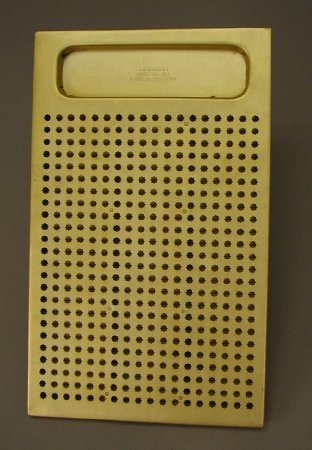Object ID:
2007.29.5
Title:
Taylor Slate
Creator:
American Printing House for the Blind
Description:
Golden anodized aluminum frame, rectangular with oval cutout at bottom; top pierced with 24x18 grid of eight-point starsl formed from two panels of stamped aluminum with folded edges, eight rivets; stamped in oval type compartment, "AMER. PRINTING HOUSE FOR THE BLIND LOUISVILLE, KY."
Dimensions:
H-12 W-7.375 D-0.375 inches
Date:
ca. 1970
Made by:
American Printing House for the Blind
Place of Origin:
Louisville, KY
Collection:
APH Collection
Provenance:
Found in office of Jim Hill. Hill worked in the APH machine shop crafting metal educational aids for many years. The Reverend William Taylor became supt. of the Yorkshire School for the Blind in 1836. While at the school he developed his "Ciphering Tablet." His calculating board is mentioned in the 1882 annual report of the British & Foreign Blind Association in essentially the same form as the model produced at APH. Although difficult to master, it possessed several advantages over its main rivals which used raised numbers. Since each piece of type could be used to represent all ten numbers and the operatives, there was significantly less time wasted searching for a particular number. APH introduced its own Taylor Slate in 1938, made from stainless steel. The tools and dies used to produce that slate were donated by the Connecticut School for the Blind in 1937. By 1953, the type was available in both lead and plastic. In 1956, APH began making the frame from anodized green aluminum, which changed to golden aluminum in 1969. The product was discontinued by 1972. Taylor slates were made by several manufacturers, including RNIB, AFB, and APH.
Credit Line:
APH Collection, 2007.29.
